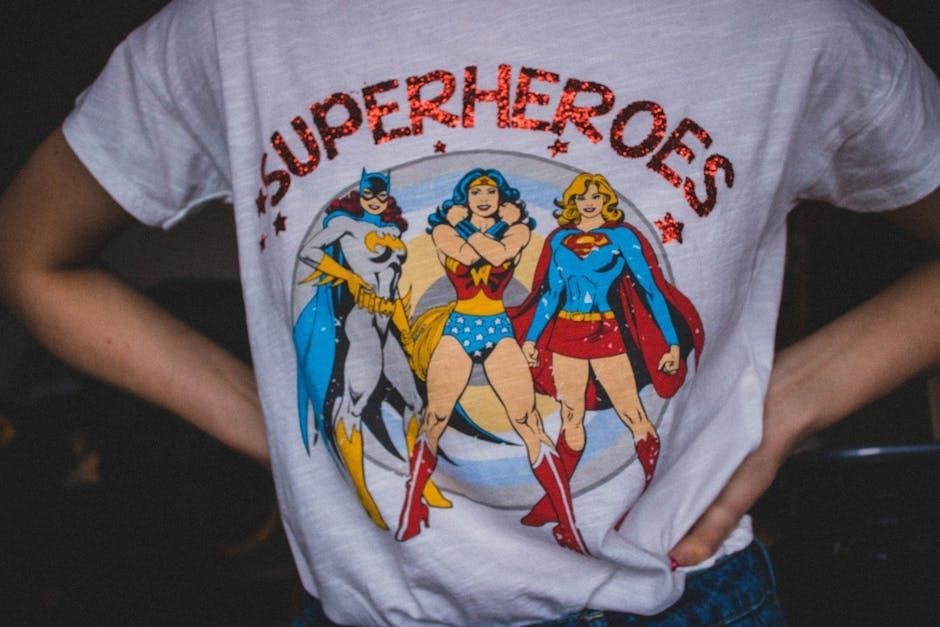Discover the ultimate guide to women’s T-shirt sizing, ensuring a perfect fit and style. Learn how to measure, choose the right fit, and explore size charts for every body type.
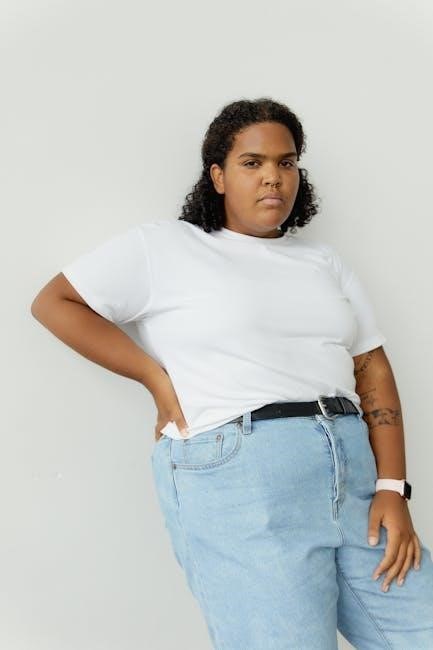
Understanding Body Measurements for T-Shirt Sizing
Accurate body measurements are crucial for determining the right T-shirt size; Key measurements include bust, waist, and hips, ensuring a comfortable and flattering fit for every body type.
2.1. Importance of Accurate Body Measurements
Accurate body measurements are essential for ensuring a comfortable and flattering fit in women’s T-shirts. Proper measurements help avoid sizing issues, such as shirts being too tight or loose, and reduce the likelihood of returns. By taking precise measurements of the bust, waist, and hips, individuals can determine their correct size and style preferences. This ensures that the T-shirt complements their body type and provides the best possible comfort and appearance. Accurate measurements also guide choices between slim, regular, or relaxed fits, enhancing overall satisfaction with the purchase.
2.2. Key Measurement Points: Bust, Waist, and Hips
Accurate measurements of the bust, waist, and hips are crucial for determining the correct T-shirt size. The bust is measured around the fullest part, ensuring the tape is level and not too tight. The waist is measured at the narrowest point, typically just above the navel. Hips are measured about 7-9 inches below the waistline. These measurements help align your body dimensions with standard size charts, ensuring a flattering and comfortable fit. Proper alignment of these points guarantees the best possible T-shirt fit.

Types of T-Shirt Fits
Explore the variety of T-shirt fits, including Slim Fit, Regular Fit, and Relaxed Fit, each designed to cater to different body types and personal style preferences for optimal comfort and appeal.
3.1. Slim Fit T-Shirts
Slim Fit T-Shirts are designed for a tailored silhouette, hugging the body closely without being overly tight. They are ideal for women who prefer a modern, fashionable look while maintaining comfort. Slim fit tees are slightly snug around the bust, waist, and hips, creating a flattering shape. They are best suited for petite or hourglass body types but can be styled to suit various figures. Pair them with jeans or skirts for a chic, versatile outfit that balances style and comfort seamlessly;
3.2. Regular Fit T-Shirts
Regular Fit T-Shirts offer a classic, comfortable silhouette that is neither too tight nor too loose. They are designed to skim the body naturally, providing ease of movement while maintaining a balanced look; Regular fit tees are versatile and suitable for most body types, making them a popular choice for everyday wear. Unlike slim-fit styles, they offer a bit more room around the chest, waist, and hips, ensuring a relaxed yet flattering fit for casual outings or layering under jackets.
3.3. Relaxed Fit T-Shirts
Relaxed Fit T-Shirts are designed for ultimate comfort, offering a loose, casual silhouette. They are cut generously, providing ample room through the chest, waist, and hips, and are ideal for those who prefer a laid-back, oversized look. Unlike slim or regular fits, relaxed-fit tees drape freely on the body, making them perfect for lounging, layering, or casual outings. Their loose design ensures ease of movement and a comfortable fit, making them a versatile choice for everyday wear.
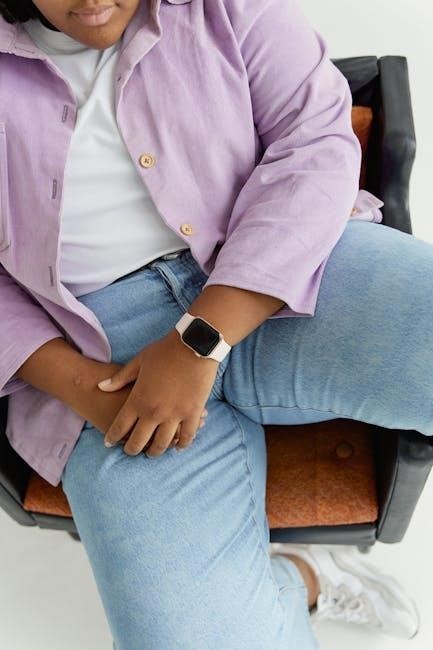
Body Types and T-Shirt Sizing
Understanding various body types—petite, average, tall, hourglass, pear-shaped, and rectangle—is crucial for selecting the most flattering t-shirt size and style for a perfect fit.
4.1. Petite, Average, and Tall Body Types
Petite, average, and tall body types require tailored approaches to t-shirt sizing. Petite women (under 5’4″) benefit from shorter sleeve lengths and torso fits to proportionally flatter their frame. Average body types can easily wear standard sizes, while tall women (over 5’6″) need longer lengths to accommodate their torso and limb proportions. Understanding these distinctions helps in selecting styles that create a balanced, comfortable fit for every body type.
4.2. Hourglass, Pear-Shaped, and Rectangle Body Types
Hourglass, pear-shaped, and rectangle body types each have unique needs for t-shirt sizing. Hourglass figures benefit from fitted styles that accentuate curves, while pear-shaped women may prefer A-line or flared designs to balance hips. Rectangle body types can opt for structured or ruffled tops to add shape. Tailoring choices to body type ensures comfort and flattery, with neckline and sleeve styles further enhancing the fit for each silhouette.

Standard Women’s T-Shirt Size Charts
Explore standard US, UK, and European size charts for women’s t-shirts. These guides provide detailed measurements for bust, waist, and hips, helping you find the perfect fit for your body type.
5.1. US Size Chart for Women’s T-Shirts
The US size chart for women’s t-shirts provides a standardized guide to help determine the perfect fit. Sizes typically range from XS to 3XL, with measurements focusing on bust, waist, and hip circumference. For example, a size S might correspond to a 34-36 inch bust, while an XL could be 40-42 inches. The chart ensures consistency across brands, allowing for accurate size selection based on body measurements. Fabric type and stretch can also influence fit, so consider these factors when choosing your size.
5.2. UK and European Size Charts
UK and European size charts for women’s t-shirts follow a similar structure to US sizes but with regional differences. Sizes typically range from XS to 3XL, with measurements in centimeters. For example, a UK size S might correspond to a 36-38 cm bust, while an XL could be 44-46 cm. These charts ensure consistency across European brands, helping consumers choose the right fit based on their body measurements. Fabric type and design can slightly alter sizing, so checking specific brand guidelines is recommended for the best fit.
5.3. International Size Conversion Guide
Our international size conversion guide simplifies shopping across global brands by aligning US, UK, EU, and other regional sizes. For example, a US size S often corresponds to a UK size M or EU size 36-38. This chart helps bridge sizing differences, ensuring a consistent fit worldwide. Whether shopping from European, Asian, or American brands, the guide enables seamless size matching, making global fashion accessible and hassle-free for women of all body types and preferences.
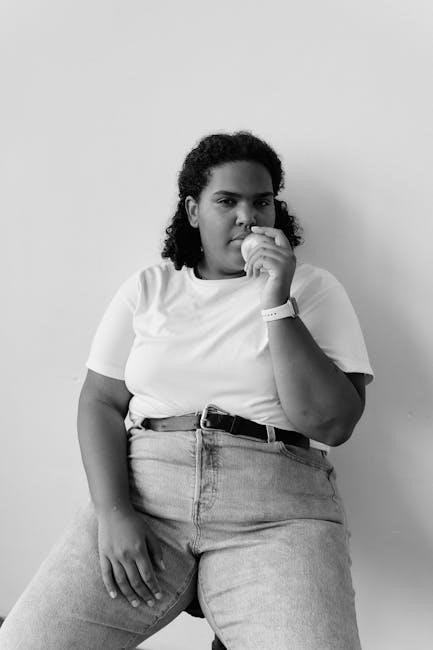
Factors Influencing T-Shirt Size
Fabric type, stretch, and style significantly impact T-shirt sizing. Different materials and designs can alter fit, making accurate measurements and size charts essential for the perfect wear.
6.1. Fabric Type and Stretch
Fabric type and stretch play a crucial role in determining T-shirt size and fit. Cotton, polyester, and blended fabrics offer varying levels of stretch and comfort. Stretchy fabrics like elastane or spandex provide a snug fit, while non-stretch fabrics like pure cotton may require a looser fit. Understanding fabric composition helps in choosing the right size, as some materials may shrink or expand after washing. Always consider fabric type when selecting a T-shirt size for optimal comfort and appearance.
6.2. T-Shirt Style and Design
T-shirt style and design significantly influence sizing and fit. Different necklines, such as crew, V, or scoop, can affect how the shirt sits on the body. Sleeve length, whether short, long, or sleeveless, also impacts measurements. Slim-fit, regular, and relaxed styles cater to various body types and preferences; Additionally, design elements like ruching or gathering can alter the fit. While style is a key factor, accurate body measurements remain essential for ensuring the best fit regardless of design choices.
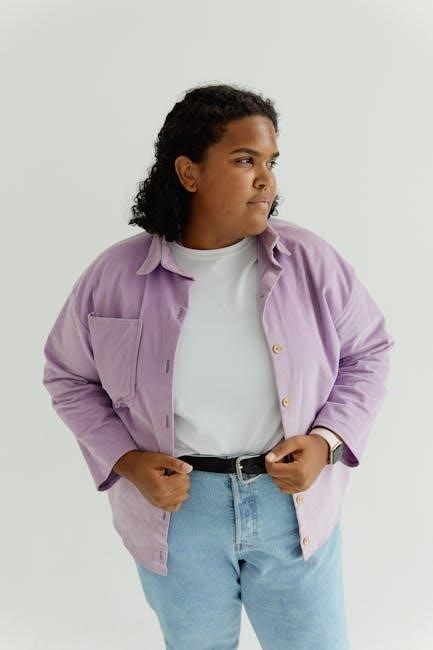
How to Measure Yourself for the Perfect Fit
Measure your bust, waist, and hips using a flexible tape measure for accurate sizing. Ensure the tape is level and not too tight for the best results.
7.1. Step-by-Step Measuring Guide
To ensure accuracy, wrap a flexible tape measure around your body. Measure your bust at the fullest point, keeping the tape horizontal. For your waist, circle the narrowest part of your torso, typically above your navel. Your hips should be measured around the widest point, about 7-9 inches below your waistline. Stand up straight and avoid pulling the tape too tight or holding it too loose; Use these measurements to compare with standard size charts for the perfect fit.
7.2. Tools and Tips for Accurate Measurements
For precise measurements, use a flexible tape measure and wear a fitted t-shirt or bra. Stand up straight and relax your muscles. Take measurements over the same clothing each time for consistency. Measure your bust at its fullest point, waist at the narrowest part, and hips at the widest point. Double-check your measurements to ensure accuracy. Compare your results to the size chart to find your best fit. Repeat the process periodically to account for any body changes.
Common Fit Issues and Solutions
Address common fit issues like shirts being too tight or loose by choosing the right size, fabric, and style. Adjust based on body type and personal comfort preferences.
8.1. T-Shirt Too Tight or Too Loose
A shirt that is too tight can restrict movement and feel uncomfortable, while one that is too loose may lack shape and style. To solve this, ensure accurate body measurements match the size chart. Fabric type and stretch also play a role—cotton blends offer more flexibility than non-stretch materials. If the fit is slightly off, consider alterations or layering for a balanced look. Always check the size chart and fabric details to find the perfect fit for comfort and confidence.
8.2. Adjusting for Body Type and Preferences
tailor your T-shirt choice to complement your body type and personal style. Petite women may prefer shorter lengths or slim fits, while taller individuals might opt for longer styles. Hourglass figures can accentuate curves with fitted designs, while pear-shaped body types benefit from A-line silhouettes. Consider fabric drape and stretch for comfort. Layering or accessorizing can enhance the fit. Ultimately, choose a style that aligns with your lifestyle and confidence, ensuring a flattering and comfortable look.
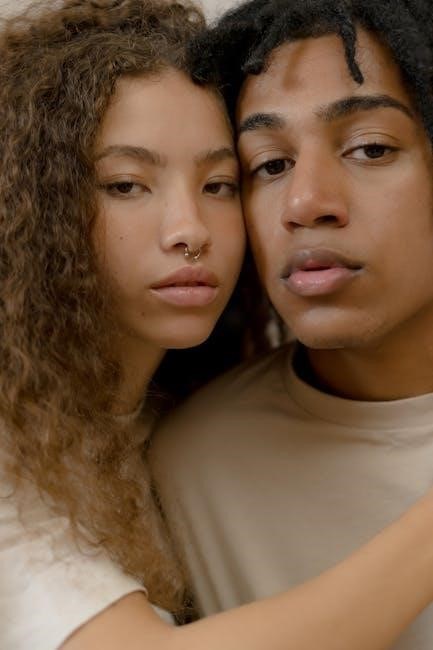
Choosing the Right T-Shirt Style
Explore various T-shirt styles, from crew necks to V-necks, and short to long sleeves. Opt for designs that flatter your body type and suit your lifestyle, ensuring comfort and confidence in every look.
9.1. Crew Neck, V-Neck, and Scoop Neck Options
Crew necks offer a classic, versatile look, suitable for most body types, while V-necks elongate the neck and balance broader shoulders. Scoop necks provide a trendy, relaxed vibe, ideal for casual styles. Each neckline complements different body types and personal preferences, ensuring a flattering fit. Choose a style that enhances your features and aligns with your wardrobe goals for a confident, stylish appearance in every T-shirt.
9.2. Short Sleeve, Long Sleeve, and Sleeveless Designs
Short sleeve T-shirts are versatile and ideal for everyday wear, offering comfort in warm weather; Long sleeves provide coverage and warmth, perfect for layering or cooler climates. Sleeveless designs emphasize the shoulders and arms, great for athletic styles or summer outfits. Each option caters to different preferences and occasions, ensuring a flattering fit while meeting lifestyle needs. Choose the sleeve style that best suits your wardrobe and personal aesthetic for a polished look.
Brand-Specific Size Variations
Different brands often have unique sizing standards, which can affect fit. Always consult the specific brand’s size chart for accurate measurements and sizing guidance.
10.1. Understanding Size Differences Across Brands
Women’s T-shirt sizes vary significantly across brands due to differences in measurements, fabric stretch, and fit styles. Some brands may cater to specific body types or offer more relaxed or tailored cuts. This inconsistency can make sizing unpredictable, even within the same size category. To navigate this, always refer to the brand’s specific size chart and consider their fit philosophy. Understanding these variations helps in making informed purchasing decisions and ensures a better fit.
10.2. Popular Brands and Their Sizing Standards
Popular brands like ASOS, Hanes, and Buck Mason offer distinct sizing standards. ASOS provides detailed fit guides, while Hanes focuses on classic comfort fits. Brands like Cos and Topshop cater to modern, minimalist styles with slightly tailored cuts. Each brand’s sizing reflects its target audience and design philosophy, making it essential to consult their specific charts. This variability highlights the importance of understanding individual brand standards for accurate sizing and a flattering fit.
Seasonal Variations in T-Shirt Sizing
Seasonal variations in T-shirt sizing account for fabric weight and fit preferences. Summer styles often feature lightweight, breathable fabrics, while winter options may include thicker, layered designs for comfort.
11.1. Summer vs. Winter T-Shirt Fits
Summer T-shirts often feature lightweight fabrics like cotton or linen for breathability, with relaxed fits to keep cool. Winter options use thicker materials and snug fits for layering under sweaters. Summer styles may include sleeveless designs or V-necks, while winter tees might have crew necks or long sleeves for warmth. Seasonal fits cater to comfort and practicality, ensuring versatility across different weather conditions and wardrobe needs.
11.2. Layering and Fit Considerations
Layering T-shirts requires careful consideration of fit to ensure comfort and style. Slim-fit T-shirts are ideal for layering under sweaters or jackets, while relaxed fits may bulk up. Consider fabric breathability and stretch for seasonal layering needs. Accurate body measurements ensure the base layer fits well, preventing restrictive or overly loose clothing. Choose T-shirts that complement your outerwear without compromising movement or comfort, ensuring a polished and practical look for any occasion.

Care and Maintenance for T-Shirts
Proper care ensures T-shirts last longer and maintain their shape. Wash inside out in cold water, avoid fabric softeners, and dry flat to preserve elasticity and color.
12.1. Washing and Drying Tips
To maintain the quality and fit of your T-shirts, wash them inside out in cold water to protect the fabric and colors. Use a mild detergent and avoid fabric softeners, as they can reduce breathability. Opt for a gentle cycle or hand wash for delicate materials. When drying, air-dry by laying the T-shirt flat or hanging it to prevent shrinkage and stretching. Avoid using a dryer, as heat can damage the fabric and cause loss of shape over time.
12.2. Maintaining Shape and Size
To preserve the shape and size of your T-shirts, store them in a cool, dry place away from direct sunlight. Avoid over-drying, as it can cause shrinkage. For cotton fabrics, consider ironing while slightly damp to restore shape. Fold or hang T-shirts neatly to prevent stretching. Avoid leaving them bunched or twisted, especially for slim-fit styles. Regularly cleaning and properly storing your T-shirts will help maintain their fit and extend their lifespan.
Online Tools and Resources
Utilize virtual sizing tools and size chart apps to find your perfect T-shirt fit. Websites like ASOS and specialized size guides offer detailed measurements and style recommendations online.
13.1. Virtual Sizing Tools
Virtual sizing tools are innovative solutions that help determine your perfect T-shirt size online. By inputting your measurements or using body data, these tools recommend the ideal fit. Popular platforms like ASOS offer virtual sizing guides, reducing guesswork and returns. They often include features like size comparisons and visual fit simulations, ensuring accuracy. These tools are especially useful for online shoppers, providing a seamless and confident purchasing experience. They also cater to diverse body types, making fashion more accessible and personalized.
13.2. Size Chart Apps and Websites
Size chart apps and websites are essential resources for determining your perfect T-shirt size. Platforms like True Fit and Size Chart offer detailed measurements and size comparisons. These tools often include international size conversions, ensuring accuracy across brands. Apps like ASOS provide personalized size recommendations based on your body type. They also offer features like virtual try-ons and fit predictions, enhancing your online shopping experience. These resources minimize sizing guesswork, helping you find the ideal fit effortlessly and confidently.
Sizing Trends in Women’s Fashion
Current trends emphasize inclusive sizing, sustainable fabrics, and body positivity, catering to diverse body types and preferences, ensuring comfort and style in every T-shirt design.
14.1. Current Trends in T-Shirt Sizing
The fashion industry is evolving with a focus on inclusivity and sustainability. Many brands now offer extended size ranges, catering to diverse body types and preferences. Sustainable fabrics, such as organic cotton and recycled materials, are gaining popularity. Additionally, there is a growing emphasis on body positivity, encouraging women to embrace their natural shapes. Technology also plays a role, with virtual sizing tools helping consumers find their perfect fit. These trends aim to make T-shirt shopping more accessible, comfortable, and environmentally friendly for everyone.
14.2. Future Predictions for Women’s T-Shirt Sizes
Future trends in women’s T-shirt sizing are expected to focus on personalization and sustainability. Advanced technologies like AI-driven size recommendations and 3D avatar fitting will likely become mainstream. Eco-friendly fabrics and zero-waste designs will gain prominence, aligning with consumer demand for ethical fashion. Additionally, inclusivity will continue to shape sizing, with more brands offering extended size ranges and gender-neutral options. The industry may also see innovative fabric blends that adapt to different body types and climates, ensuring comfort and style for all.
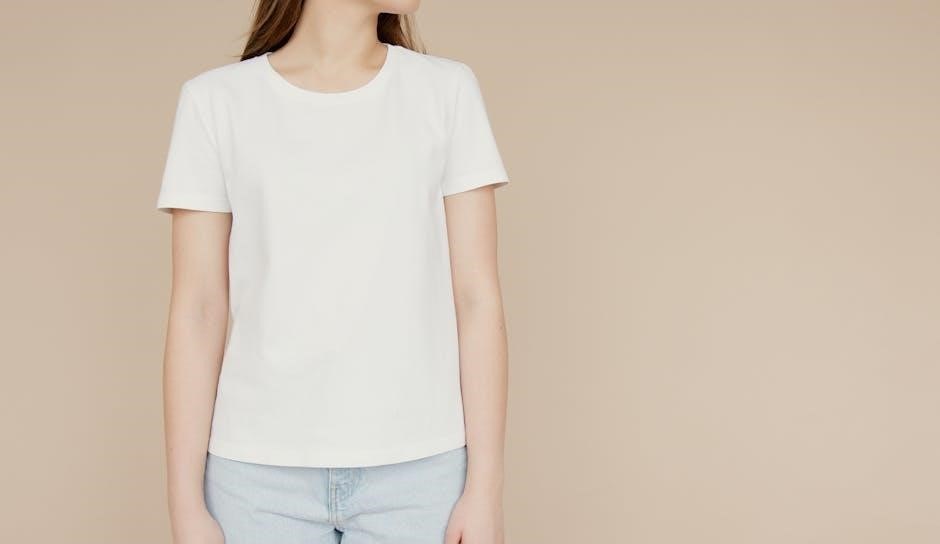
Sustainability and Ethical Sizing
Eco-friendly fabrics like organic cotton and recycled materials are gaining traction in women’s T-shirts. Ethical sizing focuses on fair labor practices and inclusive designs for all body types.
15.1. Eco-Friendly Fabrics and Sizing
Eco-friendly fabrics, such as organic cotton, recycled polyester, and Tencel, are increasingly popular in women’s T-shirts. These materials are sustainable, breathable, and gentle on the skin. When choosing eco-friendly options, sizing remains consistent, ensuring a perfect fit. Ethical manufacturing processes prioritize reducing waste and minimizing environmental impact, while maintaining high-quality garments. By opting for eco-conscious fabrics, consumers support sustainable fashion without compromising on style or comfort. This approach aligns with modern trends toward greener and more responsible apparel production.
15.2. Ethical Practices in T-Shirt Manufacturing
Ethical practices in T-shirt manufacturing focus on fair labor conditions, sustainable materials, and eco-friendly production methods. Brands prioritize transparency, ensuring workers receive fair wages and safe working environments; Eco-conscious practices reduce environmental impact, while certifications like Fair Trade guarantee ethical standards. These practices not only promote social responsibility but also align with consumer demand for responsibly sourced apparel, fostering trust and loyalty to brands committed to ethical manufacturing processes.
Mastering the women’s T-shirt size guide ensures a perfect blend of comfort and style. By understanding measurements, fits, and ethical practices, you can make informed choices. Whether for casual wear or layering, this guide provides essential insights to help you find your ideal T-shirt. Embrace confidence and comfort with a well-fitted tee, knowing you’ve explored every aspect of sizing and ethical manufacturing. This comprehensive guide empowers you to shop smart and feel great in every T-shirt you wear.
